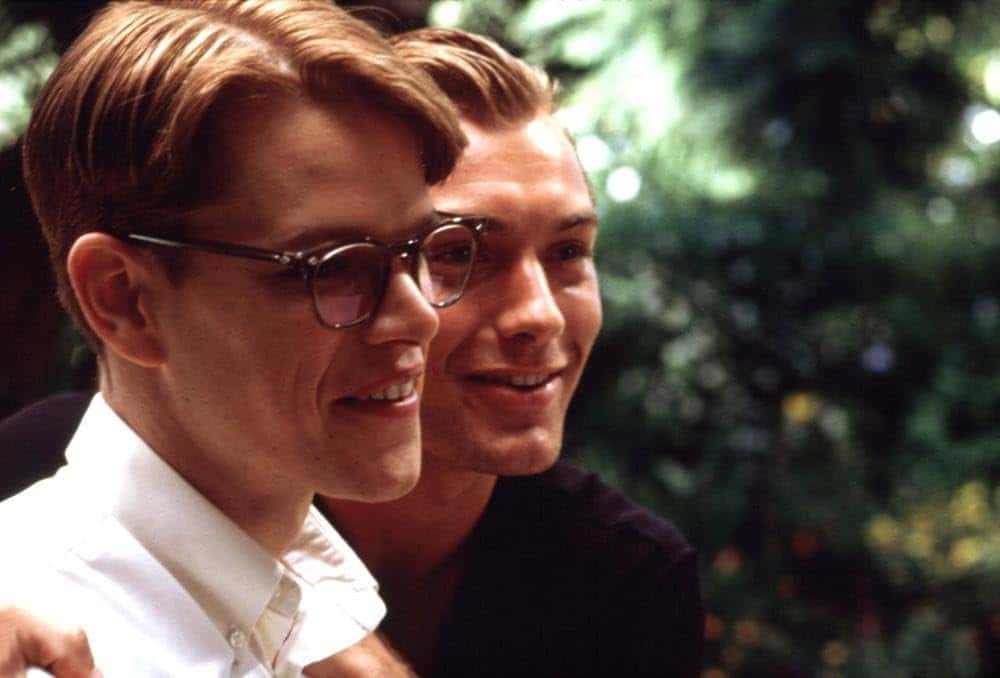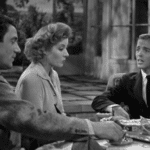Patricia Highsmith’s “Tom Ripley” has lived on in our pop culture for nearly 70 years, which for a character that, more often than not, has no sense of self-identity is quite some staying power. In this review for our series, “Revisiting ’99: Cinematic Gems and Cult Classics”, we take a look at the 1999 film ‘The Talented Mr. Ripley” starring Jude Law, Gwyneth Paltrow, Cate Blanchett, Philip Seymour Hoffman, and Matt Damon and directed by Anthony Minghella.
Patricia Highsmith’s iconic character Ripley is yet one of a series in her attempts to explore human nature, often the darker sides, by taking a look in particular at the intersections between people and their lives. Her famous book “Strangers on a Train“, made into an equally famous Hitchcock film, looks at two people with seemingly similar motivations to commit murder enter each other’s worlds for a time with the thought they’d leave each other’s behind forever after. This is not to be. Likewise Ripley’s entrance into the world of Dickie Greenleaf, a rich, lazy socialite played by Jude Law, is not just a passing fancy, but indeed a wrecking ball of Cyrus level purportions that leaves all in its wake changed.
In the opening narraration from Ripley, as played by Matt Damon, we are to believe that (paraphrasing) “if only he hadn’t borrowed his friend’s jacket” that none of events in the film would have happened. However, this is the first bit of self-delusion on the part of Tom Ripley, a character who at times can be blatantly honest with others even when deceiving himself. In fact it’s fair to say Ripley often lies to himself more than anyone else. His first real lie to Dickie’s dad Herbert, a rich shipping magnate, that he is a Yale classmate of Dickie’s leads him to Italy where, with a substantial payment from Herbert, he is tasked to bring back Dickie to America. Instead Ripley befriends Dickie and his girlfriend Marge, played by Gwyneth Paltrow, and slowly he begins to try on Dickie’s lifestyle, and increasingly Dickie’s life.
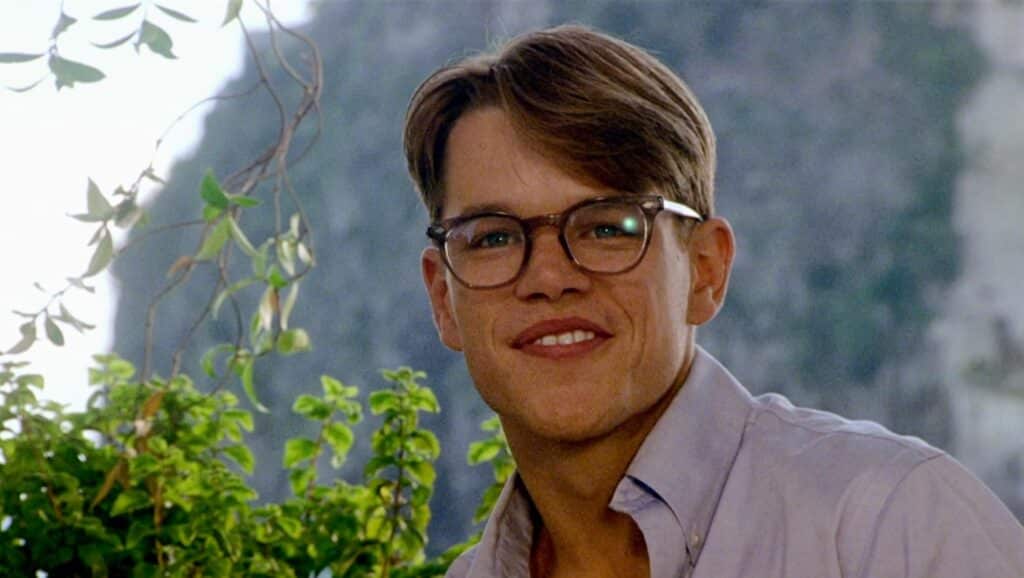
Matt Damon in The Talented Mr. Ripley
Ripley is more lucky than he is talented, as he takes advantage of every passing misconception by others, including Cate Blanchett’s Meridith, a socialite herself, who presumes Ripley upon his first meeting to be Dickie. These are the coincidences that give Ripley his real power as relies more often on luck than any real talent, though his penchant for voices – expertly demonstrated by Damon’s own acting talents – and signature forgery do show up on occasion. Unlike Damon though, who is 100% committed to the role in every moment, Ripley is at times a fish out of water, and this is what leads to the conflict of the film. Ripley wants Dickie, but he wants to be Dickie, and given his rare penchant for honesty with Dickie – nearly always being truthful, at least comparatively – it’s no wonder things come to a head.
If you are at all familiar with this film then you may know of the crucial set piece at the center of the film. I only knew vaguely; however, the obvious inevitability of this scene (or a scene like it I thought) actually let me to be rather disinterested with the first third of the film. I felt at least as far as the film – having not read the book – this was a bit too predictable, especially having read other Highsmith books. What excited me however was that this set piece occurred so early, and thus the last two-thirds were largely a mystery. I should have given Highsmith more credit perhaps, as this is often where she excels, but I was concerned this might be the climax. I had forgotten however that in her books it’s not the how these intial intersections start that she finds interesting afterall, but the fallout thereafter.
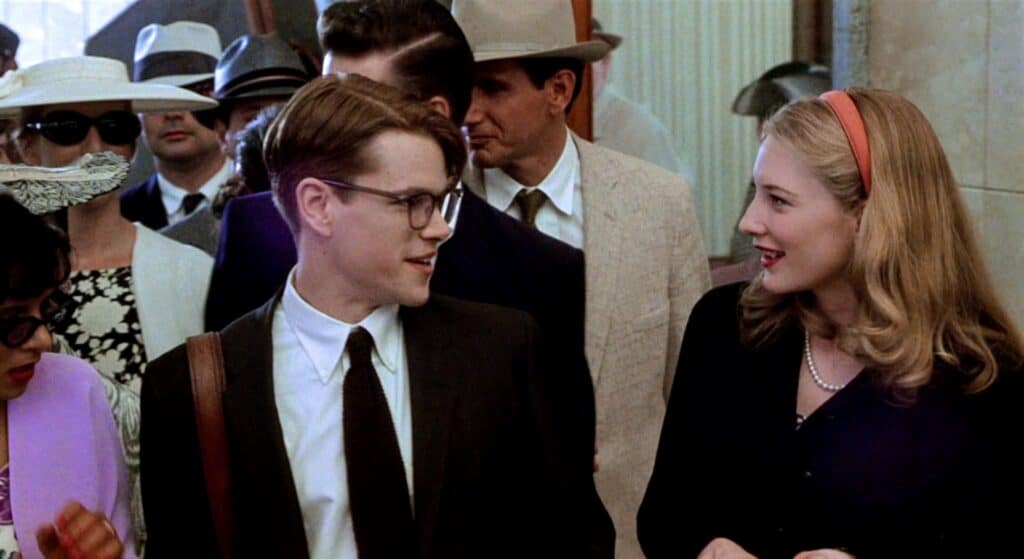
Matt Damon and Cate Blanchett in The Talented Mr. Ripley
What a fallout indeed as we see a significant amount of chaos that follows, and though I think the weaknesses of the film also shine through – primarily the feasibility of the action drops dramatically – but you can’t help but be transfixed through a substantial portion of the last two thirds. This is where one revelation that had honestly never occurred to me came through, which is that Paltrow, especially in this film, truly has a gift for acting as she expertly plays a full range of emotions as Marge, sometimes nearly all at once as is demonstrated in two late key scenes. Her best films, or so I’ve been told, are nearly all movie blindspots for me, so perhaps I’d just never had a better introduction than Pepper Potts. Blanchett too, who likewise has been a bit of a blindspot though I’ve seen her excel more often, excellently plays Meridith, who we are so clearly seen as a character to be playing her own role for though rich, wealthy, and beautiful, its clear she’s merely trying to fit in with her socialite peers. She too is trying to play the character folks imagine her to be, and to wear the jacket of the life she wants to live, or that she thinks others want her to live.
Lastly I cannot say enough about Damon. Though never could I conceive anyone to see Jude Law and Matt Damon as one and the same – the biggest ask of the film – Damon’s abilities to transform himself through voice and mannerisms, when he needs, is transfixing. Less was I impressed at his ability to “mimic” other people, than to just make me forget that Damon – one of our best actors working today – was no longer Damon. Yet I forgot that time and time again. Damon’s ability to capture the audiences attention made up for the many, many false endings – I swore the movie was over five times before it really was, and left the greatest positive impression on me.
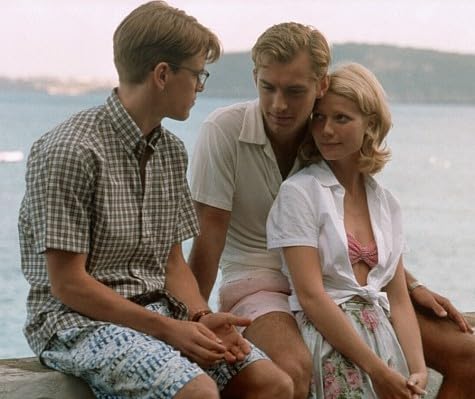
Matt Damon, Jude Law, and Gwyneth Paltrow in The Talented Mr. Ripley
I’d be remiss not to discuss the sex and sexuality of the film as well, which as a relatively LGBTQ-forward film put it ahead of its time in 1999. Though it’s just as likely that Ripley’s use of sex would be to foward any of his gains – and the only sex scene in the film is a straight one – the film’s significant homoeroticism is crucial and a defining element of Dickie and Tom’s relationship. Perhaps Tom’s first lie to himself was regarding his sexuality as well, but again we’re given too little backstory to know and we only see how Tom engages with sex after he meets Dickie. Even as forward as this film is it’d be interesting to imagine this film if it were made today, which is likely just a small part of why Netflix is doing that with its Ripley series.
Ultimately I came away relatively positive on this film though the movie is strongest when it is character forward, putting its stars front and center. When you have to think too much about the plot, or are tricked by yet another false ending – it was quite clear this film did not know where to end – the movie feels a bit thin. Likewise the themes I imagine Highsmith wanted to interrogate, including class, the ability of men to fail up, identity crises, ultimately all felt watered down as the film wanted to have it both ways with the “endings”. (Paltrow’s last scene to me would have been the perfect ending, as it would send a harrowing message sadly all too relevant for our time as it was Highsmith’s; however, the film went on for several more minutes only to muddle the water.) Though it’s not a film I plan on revisiting anytime soon, its gave my mind a lot to chew over and its clear why its had staying power, as we know Dickie Greenleafs, we see Tom Riddle caricatures abound in the real world, and now with the new Netflix series Ripley it’s clear we’re interrogating men like them, and the webs they weave, just as much now as we were in 1999 upon the film’s release and in 1955 when Highsmiths’ book first debuted.
